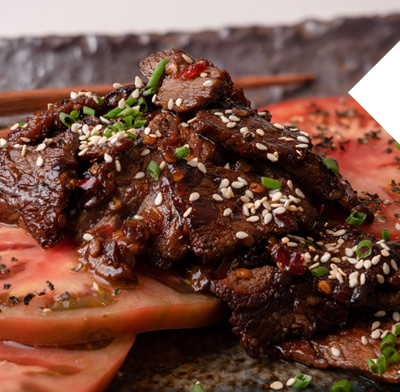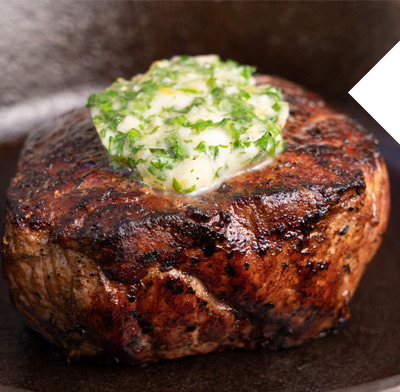When I look out over the Roche Harbor Marina in the summer, I can see that we are not the only cooks in the harbor. Under the plumes of BBQ smoke, some amazing cooks prepare feasts that would rival Martha Stewart, but what makes these dinners so impressive is that they are created spontaneously with a cocktail in one hand and a pair of tongs in the other. Walking down the docks between 1700 hours and 1800 hours in the evening is a culinary journey into the lifestyle of marinas all over the Northwest.
Grilled local spot prawns, seafood paella, Maui-style Kalbi ribs, corn on the cobb, grilled oysters with garlic butter, smoked baby back pork ribs, herb marinated salmon, and every steak you can imagine—these are only a sampling of what is being grilled on the back of the boats. Conversation, laughter, and great food travel from the small grills on the boats to tables on the docks.
July is barbeque month and I wanted to share a few recipes with all you as well as some tips on buying steaks and, most importantly, cooking them to perfection. A few of us are lucky enough to know a butcher that hand selects and trims steaks that are always spectacular, but for most of us buying beef can be a little confusing.
When buying beef for a barbeque, the most popular steak throughout the world is the rib eye, followed by the New York, tenderloin and top sirloin. These are excellent choices for any barbeque, but there are a few other factors we need to consider when buying great steak.
Tenderness: The grade of beef is an indicator of how tender a steak will be, and the USDA has divided steaks into three grades; select (the lowest grade with very little fat marbling), choice (the middle grade with modest to moderate fat marbling), and prime (the highest grade with abundant marbling).
When looking through the steaks at the market, look for the steaks that have the most amounts of little white flakes of fat throughout the muscle. These steaks will be more flavorful and tender.
Age: Believe it or not, we like our beef a little ripe and most restaurants age their beef for at least 21 days. Aging adds flavor and tenderness to the beef. Sadly, most grocery store age their meat only seven days. Ask your butcher for 21-day aged steaks.
Thickness and Trim: I prefer a steak that is at least 1-inch thick, thin steaks tend to cook too quickly and dry out, but the most important reason for a thick steak is flavor. The crust or outer edge of a steak seasoned well and cooked at high heat changes the flavor of the meat by caramelization. This caramelized outer crust combined with the slightly sweet and juicy flavor of the interior creates the perfect flavor combination. Trim off any excess fat or unwanted bits. A little fat is needed for flavor while cooking, however.
Now that we have purchased the best quality meat available, the next step is perfecting the art of the grill. Gas, charcoal, or a good cast iron pan equally cook a great steak. Two hours before dinner, remove the steaks from the refrigerator and season them with your favorite steak salt, then allow them to sit at room temperature. Thirty minutes before dinner, turn on your grill to high. The heated grates caramelize the outer crust.
When you are ready to grill, brush the grates with vegetable oil, and place the steaks at a 45-degree angle to the grates. Grill until dark grill marks appear on steak, about 2 minutes, use tongs to lift the steaks (it will release easily from grates when marked sufficiently). Change the angle to the grates in the opposite direction for 2 minutes. Turn the steak over and cook for 4 minutes. To judge the doneness, turn the steak on its side and insert a 0˚ to 220˚ probe-type thermometer into the center of the steak and follow the chart at the end of the article.
 |
Thai Steak TidbitsWhenever I break down a large piece of meat or cut my own steaks, I am troubled by the amount of pieces of trim meat that has the same great flavor of the steaks but in the wrong shapes and sizes. Grinding the meat into burger and using in stir fry are both good options, but when we are working with a high-quality cut like prime rib eye it seems like such a waste of the outstanding beef flavor. This recipe is quick and easy and uses ingredients commonly found in your pantry. Serves 6
Directions: Heat a 10-inch cast iron skillet over medium high heat. Season meat with salt and pepper. Add seasoned beef to skillet, sauté beef until it begins to brown. Add soy sauce, sweet red chili sauce, and Sriracha. Continue to sauté and move meat around in pan, coating each piece with the sauce. As the meat cooks, the sauce will begin to caramelize around the meat and harden. When all of the sauce has evaporated and coated the meat, remove from pan and place on a warm serving platter. Garnish with sesame seeds and green onions. Serve with chopsticks or toothpicks. |
 |
Rib Eye SteakOf all the cuts of beef to choose from, the rib eye is the most popular in the world because of its rich beef flavor and tenderness, but the cap of the rib eye is the single most delectable and flavorful steak available. This steak is the most rich, buttery, tender, and beefy steak you will ever taste and intended to be eaten slowly with a big, voluptuous cabernet sauvignon. The rib eye is best when cooked quickly over high heat in a seasoned cast iron skillet or cast iron grill. Serves 6
Directions: Heat a 10-inch cast iron skillet over medium-high heat. Season steaks with salt and pepper. Add butter to skillet and after the butter has melted, place steak in skillet and allow to brown on one side for 3 to 4 minutes. Turn steak over and sear for an additional 3 to 4 minutes or until the steak reaches an internal temperature of 115˚ – rare, 125˚ – medium rare, 130˚ – medium, 140˚ – medium well and 150˚ – well. Remove from pan, cover with an aluminum foil tent, and allow to rest for 15 to 20 minutes. Chef’s Notes: Resting steaks allow the meat to relax and finish but more importantly prevents the steak from releasing all of the flavorful juices when cut. |
Tuscan Steak Butter
Directions: Remove two sticks of unsalted butter from the refrigerator and set out for 2 hours to soften. In a small bowl, combine softened butter and remaining ingredients. Blend with a wooden spoon to incorporate all the ingredients. Tear off a 12-inch length of parchment paper and place the butter compound at one end. Work the butter into a log shape that is one inch in diameter, then roll up the paper tightly around the butter log. Wrap log in plastic food wrap and freeze until needed. Chef’s Notes: Steak butter can be made ahead of time, rolled in parchment paper, then frozen. When needed, pull the frozen butter log from the freezer and slice into ½ inch thick coins and place on each steak after cooking As the butter melts, it combines with the steak juices, creating a rich and flavorful sauce. |
Chimichurri SauceMakes 1 cup
Directions: To make the chimichurri, add parsley, red wine vinegar, garlic, shallot, oregano, red pepper flakes, kosher salt and olive oil into a blender or food processor. Pulse ingredients until well chopped, but not pureed. Serve with steak. Chef’s Notes: Americans eat over 70 pounds of beef anually, but Argentines eat over 130 pounds and flavor their steaks with only sea salt and an aromatic earthy sauce called chimichurri. Chimichurri was created by Basque settlers in Argentina and is open to many interpretations. While grazing their sheep, Basque shepherds would gather herbs and wild garlic as they roamed through the foothills of the Andes. When evening came, they would combine what they had collected along their journey with vinegar and olive oil from a backpack and serve with a fire-roasted chunk of fresh lamb. Today, chimichurri is considered to be a perfect companion to beef. |
Know Thy Steak
| Degree of Doneness (Code) | Exterior Description (Touch) |
Interior Description |
Internal Temp. of Broiler |
| Blood-Rare (BR) | Soft and pulpy. Surface should be dark brown. | Seared exterior, very red interior; center is cool and almost raw. Juice is bloody. | 95°—105° |
| Rare (R) | Indentation springs back slowly. Meat is relatively soft. Juices show red when pressed. | Good crust, Very red warm center. Juicy but not bloody. | 105°—115° |
| Medium-Rare (MR) | Slightly resistant. | Still has small red center. Center is very warm. | 115°—125° |
| Medium (M) | Indentation springs back quickly. Meat is firmer. Juices lighter when pressed. | Pink, no red. | 125°—135° |
| Medium-Well (MW) | Meat is firm. No indentation. | Pink is almost gone. | 135°—145° |
| Well-Done (WD) | No indentation. Meat is very firm. Juices clear. | Interior is brown. | 145°—155° |